
When a concert version of Andrew Lloyd Webber and Tim Rice’s Jesus Christ Superstar first opened at the Adelaide Arts Festival in 1972, it was to an enraptured but sometimes scandalised public. Protesters carried placards outside the venue, thinking the musical version of the last few days of Jesus’ life, from Palm Sunday through the crucifixion, was blasphemous. The protests appeared before the first electric guitar notes of the overture had ever rung out over an audience.
“We had just done a sound check, and Jon [English, who played Judas] and I were walking back across the park to our digs before getting ready for the show,” recalls Trevor White, who played Jesus in that first production. “And there were some people out there with banners and placards and so on, and Jon, being a bit cheeky, said, ‘Oh, have you seen the show?’ And of course, they couldn’t have done because it hadn’t been on ... But I think once people saw it we managed to win them over.”
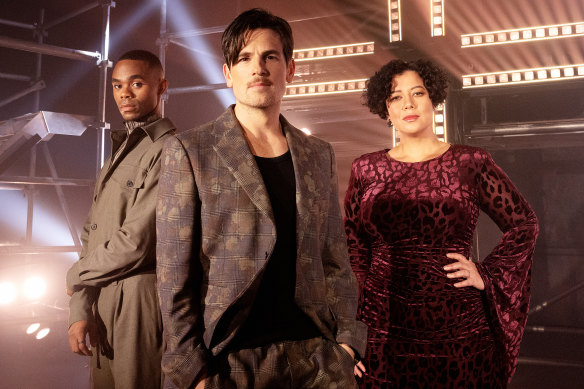
Stars of new production of Jesus Christ Superstar: (from left) Javon King, Michael Paynter and Mahalia Barnes.Credit: Juliet Taylor
There was one group White wasn’t sure would be won over, once the show opened at the Capitol Theatre in Sydney. He remembers peering out into the audience and getting a bit of a shock. “There were literally two rows of nuns who had come to see the show. And we thought, ‘We could be in for some heckling tonight.’ As it turned out, they were all at the stage door for autographs after.”
The show has been revived twice on Australian main stages, to rapturous crowds. It’s about to open again, with Michael Paynter as Jesus, Javon King as Judas, Mahalia Barnes as Mary Magdalene and comedian and outré cabaret singer Reuben Kaye as King Herod.
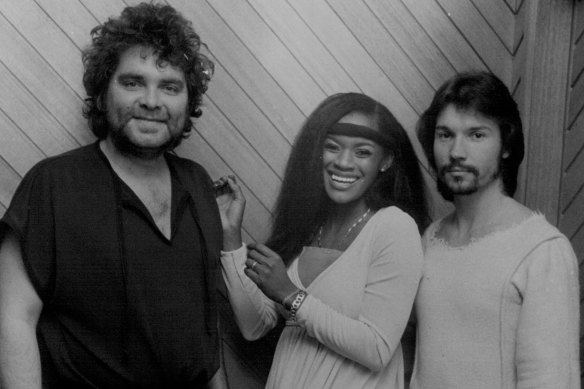
Doug Parkinson as Judas, Marcia Hines as Mary Magdalene and Trevor White as Jesus from the 1972 Australian production.Credit: Jacqueline Haynes-Smart/Fairfax Media
Even the Vatican abandoned its feud with the musical in 1999, officially endorsing the show and putting on a production as part of year 2000 jubilee celebrations. But there is still a section of the Australian public who take perceived blasphemy extremely seriously, as Kaye learnt after telling an off-colour joke on Ten’s The Project in 2023: “I love Jesus. I love any man who can get nailed for three days straight and come back for more.”
What followed stunned Kaye, who says he didn’t tell the joke to be provocative. “If you’ve been to one of my shows, you know it is one of the tamer things I say,” he says. He had told the joke thousands of times on stage but decided to tell it on broadcast TV to retire it. But although the studio audience laughed, Kaye was threatened and hounded for the better part of a year. There were death threats against him and those around him. “Whereas before, I had really felt very safe in Australia as a progressive, sort of quite artistically savvy nation, at least within my audience,” he says. “And then that shrank very quickly. And it was very scary, not just for me, it was scary for my family, who were put on a police priority response list. It was scary for my management, who also had people breaking into their office and having threats sent.”
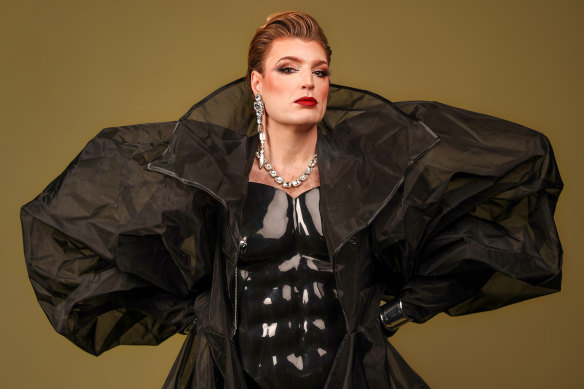
Reuben Kaye describes his King Herod as a “power-hungry, extravagant child nepo baby”.Credit: Dylan Coker
Kaye thinks the outrage came more from homophobia directed at a visibly queer, camp man on prime-time TV than from serious religiosity, but the incident perhaps adds a dimension to his casting as King Herod. He says he has some apprehension going into the role, “but I also have a very fiery sense of f--- ’em ... If they can’t see the irony in trying to publicly crucify a Jew over what he says, that, to me, is the greatest joke of all.”
He says he asked the costume department to swap out Herod’s crown for horns, but they didn’t go for it. He did make some modifications to the costume, but he’s tight-lipped as to what they might be. Given Kaye turned up to this magazine’s cover shoot with his own glorious gowns, the costume is sure to be magnificent.
Herod’s appearance is one of the show’s highlights, a gloriously over-the-top upbeat number where the puppet king demands Jesus prove his divinity before turning him back to Pontius Pilate. Australian superstars from Reg Livermore to Angry Anderson have made the role their own, but Kaye is taking his cues from the historical record.
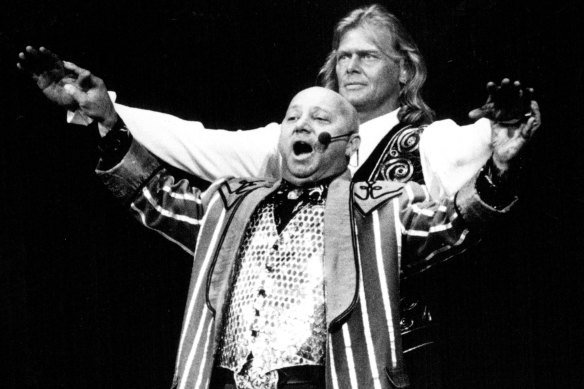
Angry Anderson, as King Herod, and John Farnham, as Jesus, in the 1992 concert version of Jesus Christ Superstar.Credit: Michele Mossop
“Herod’s dad, also called Herod, had his brother-in-law drowned in their swimming pool at an orgy. So when Herod says, ‘Walk across my swimming pool’, there’s so much history and in-jokes there. Herod Agrippa, who I’m playing, married his sister-in-law, and just spent so much of the public money building these fabulous buildings and was just this sort of extravagant but slightly incompetent leader who really wanted the title of king, and he kept on not being given it. And he begged and begged and irritated Augustus or Octavia – they’re the same person, different names. And eventually, he went, ‘Oh, you’re a bit annoying. Can you f--- off, please?’ And they exiled him, and he totally fell from grace. So he really is, in my mind, this clueless, power-hungry, extravagant child nepo baby.”
The role is generally the most over-the-top in the show, making it perfect for Kaye, who performs in scarlet lipstick and false eyelashes the size of huntsmen. “He’s this sort of disco ball terrorising the entire company, it’s brilliant,” says Kaye. “I don’t think I’m going to have to try hard to be outrageous.”
Behind the sparkles, handsprings and dancing girls, Kaye says Herod is a homicidal maniac with no real power and describes his song as “throwing his toys out of the pram for four and a half minutes. What a joy!”

John Farnham and Kate Ceberano perform in Jesus Christ Superstar in Melbourne in 1992.Credit: The Age
Like most Australians, Kaye associates the show mostly with the 1992 revival concert tour starring John Farnham as Jesus and Kate Ceberano as Mary Magdalene, though he did not catch it live. “Obviously, I was too young, as I’m only 21 years old,” he says (Kaye turned 40 in September, but it seems rude to mention this). “But I’ve watched it so many times. John Farnham’s performance in that is outrageous, Angry Anderson in the cowboy outfit [as King Herod]. And the orchestrations of that concert are some of the best orchestrations of Jesus Christ Superstar I think we’ve had until this production.”
Associate director Alli Coyne, who toured with the current version of Superstar in the UK and is now bringing it to Australian audiences, agrees that Farnham’s version is gospel in Australia. The most recent big production of the show was in 2013, a stadium tour with Tim Minchin as Judas Iscariot and ex-Spice Girl Melanie C as Mary Magdalene, is not the one etched in Australians’ minds.
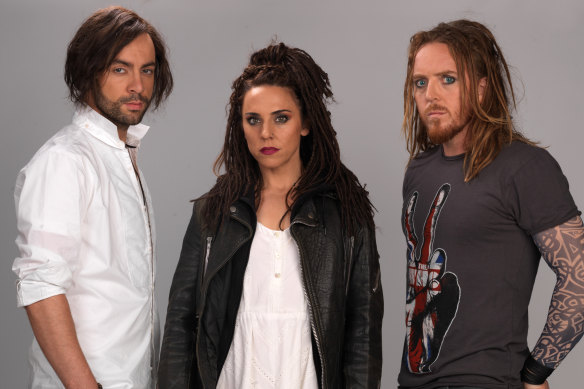
Ben Forster, Melanie C and Tim Minchin featured in the 2013 stadium tour.
“Although that was the last production here, the one that the cast talk about is the John Farnham version, they talk about that one a lot,” she says. “I think that’s the biggest one that everybody will compare us to, rather than the stadium show.”
Without a stadium environment to differentiate the show from the most famous version, how will the new production stand out?
“The idea was to go back to the brown album, which was the original album, and take it very much from the music,” says Coyne. “The whole idea of the show is that you literally put that little stylus on the LP at the beginning, and it just keeps evolving. It just keeps moving all the way through.”
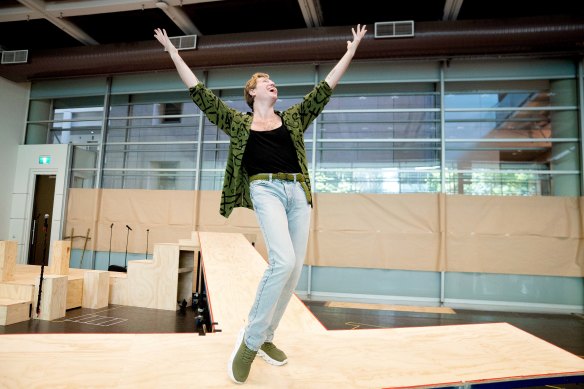
Reuben Kaye, who plays Herod, in rehearsal for Jesus Christ Superstar at Ultimo.
The music is, of course, some of the most famous of Lloyd Webber and Rice’s careers (Coyne says audiences usually start singing along when the company launches into Hosanna), but it receives a particularly exalted status in this rendition, says Kaye.
Loading
“This show focuses on sort of the music and the musical aspect of it,” he says. “So there’s a lot of mics being handed over as sacred objects. There’s a lot of guitars. It’s more about Jesus being given rock star icon status to sing this one song and become an icon forever. So in the same way that we look at a religious figure being exalted, and the difference between religion and faith and where corruption lies, you could also look at that as what is an artist versus what is a star. That’s a really interesting meditation for me, in terms of where I’ve been going on my journey, and certainly for everyone else to look at in the age of social media, in the age of instant, unearned fame.”
The very first Australian production included mics being handed over, too, but it was a necessity of pre-cordless amplification. And it did not always go smoothly.
“Stevie Wright [of the Easybeats fame who played Simon Zealotes] would hand me the microphone after he’d sung his big song,” recalls White. During one memorable performance, the cord became detached during the handover.
“You can’t have Jesus doing a bit of mechanical wizardry,” he says. “I had to sing this very quiet passage, and almost in frustration, I decided, ‘They’re not going to hear me without a microphone.’ So I sang it up the octave and belted it out in a sort of blues style. And I could see the shock on the faces of the cast as they retreated in their characters. But afterwards, they came up and said, ‘Wow, that was incredible. Keep it in.’”
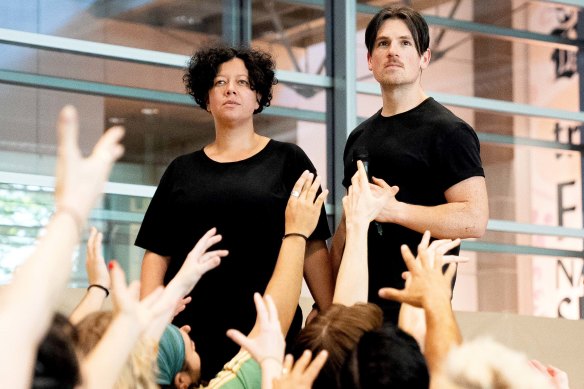
Mahalia Barnes and Michael Paynter during rehearsals for Jesus Christ Superstar.Credit: Jake Percey
White auditioned for the part of Jesus because “it’s called Jesus Christ Superstar”, but Coyne says the new production centres on ambivalent disciple Judas more than the titular star. Kaye says that has always been his reading of the show.
Loading
“I think it’s Judas’ show,” he says. “He’s a man caught between a rock and a hard place, and that opening number of Heaven on Their Minds just centres him. The dilemma that he goes through, the journey he goes through, is so extraordinary and tragic that it has to be Judas’ show, but that’s also one of the great things that I think we all struggle with. Judas is an everyman because Judas is struggling with the idea of God and divinity, and is it real? He’s struggling with the corruption of and the purity of an idea.
“And I think now more than ever, that struggle is felt by everyone here, everyone on Earth is in some way. How can you believe in the divine, when all you see is corruption and know that you’re part of that corruption or part of that problem? What is the answer to everything and anything? And the next step of that question is, what is the answer to me? And Judas has no answer to that. I don’t know if Judas gets one, and that’s something I think cuts through all of the sparkle, the glamour, the showbiz of this show, and maybe that’s why it’s everlasting.”
Jesus Christ Superstar opens at the Capitol Theatre, Sydney, on November 6; and the Princess Theatre, Melbourne, March 16, 2025.









 Add Category
Add Category